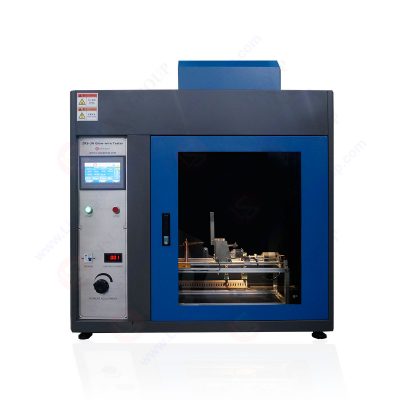

Abstract
This paper focuses on the ZRS Glow Wire Tester, specifically the LISUN ZRS-3H Glow-wire Test Apparatus, analyzing its application in flame retardant testing within quality supervision sectors and enterprises. Flame retardant properties are essential in ensuring the safety and compliance of various materials, especially in the electronics, electrical, and manufacturing industries. The ZRS Glow Wire Tester plays a critical role in assessing the ignition risk of materials under thermal stress, helping organizations align with safety standards such as IEC 60695-2-10. This study explores the testing processes, advantages, and data gathered from ZRS Glow Wire testing, providing insight into how this equipment aids in quality and safety assurance.
1. Introduction to ZRS Glow Wire Tester
The ZRS Glow Wire Tester, specifically the LISUN ZRS-3H model, is designed to evaluate flame retardancy by subjecting materials to high-temperature thermal stress. This method simulates potential fire hazards by replicating scenarios where electrical components could ignite due to overloads or other failures. The ZRS Glow Wire Tester applies a hot wire to the test specimen, determining the material’s flammability and assessing its resistance to ignition.
Table 1: Specifications of LISUN ZRS-3H Glow Wire Tester
Specification
Value
Temperature Range
Up to 1000°C
Control System
Microprocessor-based
Heating Rate
960°C in less than 30s
Display
Digital display
Standards Complied
IEC 60695-2-10, 11, 12, 13
Test Duration
0-999.9s
2. Importance of Flame Retardant Testing
Quality supervision and related enterprises rely heavily on flame retardant testing to ensure product safety and regulatory compliance. With the ZRS Glow Wire Tester, companies can identify materials that may fail under fire risk scenarios, allowing them to enhance product safety and meet international standards. These tests are particularly relevant to manufacturers of electronics, electrical appliances, and components that could pose fire hazards if compromised.
3. Working Principle of the ZRS Glow Wire Tester
The ZRS Glow Wire Tester operates by heating a metal wire loop to a specified temperature and pressing it against a test specimen for a defined period. If ignition occurs, the tester records the ignition time (Ti) and flame persistence time (Te), providing data that indicates the material’s flammability and self-extinguishing characteristics.
ZRS-3H Glow-wire Test Apparatus
4. Detailed Testing Procedure
• Setup: The ZRS Glow Wire Tester is calibrated to the target temperature, typically set between 550°C and 960°C depending on testing requirements.
• Sample Preparation: A standard-sized specimen is prepared from the material to be tested.
• Test Execution: The heated wire is applied to the specimen with a controlled force, simulating a short-term thermal load.
• Data Recording: The ignition and flame persistence times are recorded, along with any visible damage or deformation on the specimen.
• Analysis: The results are compared against specified criteria to determine compliance with flame retardancy standards.
Table 2: ZRS Glow Wire Tester Sample Testing Results
Material Type
Test Temperature
Ignition Time (Ti)
Flame Persistence Time (Te)
Result
ABS Plastic
650°C
12s
15s
Pass
Polycarbonate (PC)
850°C
0s
10s
Fail
PVC
750°C
5s
0s
Pass
Nylon
900°C
8s
25s
Fail
5. Data Interpretation and Analysis
From the above results, it can be observed that ABS and PVC have shorter flame persistence times, suggesting better flame retardant properties compared to Polycarbonate and Nylon under the same test conditions. The data illustrate how different materials respond to thermal stress, helping quality supervision departments to make informed decisions on the use and restriction of certain materials in specific applications.
6. Advantages of Using ZRS Glow Wire Tester
• Precision and Accuracy: With a microprocessor-based control system, the ZRS Glow Wire Tester provides precise temperature control and accurate data readings, ensuring reliable results.
• Compliance with Standards: The ZRS Glow Wire Tester complies with IEC 60695-2-10 and related standards, making it suitable for regulatory testing.
• Efficiency in Testing: Its rapid heating system enables tests to be completed quickly, saving time in laboratories and production environments.
• Safety Assurance: By identifying potential fire hazards in materials, the ZRS Glow Wire Tester supports safer product designs and enhances public safety.
7. Application in Quality Supervision and Enterprises
The ZRS Glow Wire Tester is particularly valuable for quality control departments and manufacturers who need to comply with stringent flame retardant standards. Through routine testing, organizations can detect and mitigate potential safety risks associated with their products.
8. Conclusion
The ZRS Glow Wire Tester is an essential tool for quality supervision departments and enterprises focusing on flame retardant testing. With its ability to simulate thermal stress scenarios, it provides a detailed understanding of how materials respond to high temperatures, allowing companies to improve product safety and meet regulatory standards. Through precise and efficient testing processes, the ZRS Glow Wire Tester supports the ongoing commitment to quality and safety in various industries.
References
For further information on the LISUN ZRS-3H Glow-wire Test Apparatus, visit the official product page at: LISUN Glow-wire Test Apparatus. https://www.lisungroup.com/news/technology-news/application-and-significance-of-zrs-glow-wire-tester-in-flame-retardant-testing-for-quality-supervision-departments-and-related-enterprises.html
.jpg)

Comments
Post a Comment